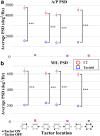The effects of actuator selection on non-volitional postural responses to torso-based vibrotactile stimulation
- PMID: 23406013
- PMCID: PMC3637278
- DOI: 10.1186/1743-0003-10-21
The effects of actuator selection on non-volitional postural responses to torso-based vibrotactile stimulation
Abstract
Background: Torso-based vibrotactile feedback may significantly reduce postural sway in balance-compromised adults during quiet standing or in response to perturbations. However, natural non-volitional postural responses to vibrotactile stimulation applied to the torso remain unknown.
Methods: The primary goal of this study was to determine, for two types of actuators (tactors) and in the absence of instruction, whether vibrotactile stimulation induces a directional postural shift as a function of stimulation location. Eleven healthy young adults (20-29 years old) were asked to maintain an upright erect posture with feet hip-width apart and eyes closed. Two types of tactors, Tactaid and C2, which differ in design and stimulation strength, were placed on the skin over the right and left external oblique, internal oblique, and erector spinae muscles in a horizontal plane corresponding approximately to the L4/L5 level. Each tactor of the same type was activated twice randomly for each individual location and twice simultaneously for all locations at a frequency of 250 Hz for a period of 5 s.
Results: Vibration applied over the internal oblique and erector spinae muscle locations induced a postural shift in the direction of the stimulation regardless of the tactor type. For the aforementioned four locations, the root-mean-square (RMS) and power spectral density (PSD) of the body sway in both the A/P and M/L directions were also significantly greater during the vibration than before or after, and were greater for the C2 tactors than for the Tactaid tactors. However, simultaneous activation of all tactors or those over the external oblique muscle locations did not produce significant postural responses regardless of the tactor type.
Conclusion: The results suggest that the use of a torso-based vibrotactile sensory augmentation display should carefully consider the tactor type as well as the instruction of corrective movements. Attractive instructional cues ("move in the direction of the vibration") are compatible with the observed non-volitional response to stimulation and may facilitate postural adjustments during vibrotactile biofeedback balance applications.
Figures







Similar articles
-
Directional postural responses induced by vibrotactile stimulations applied to the torso.Exp Brain Res. 2012 Oct;222(4):471-82. doi: 10.1007/s00221-012-3233-2. Epub 2012 Sep 12. Exp Brain Res. 2012. PMID: 22968737
-
Effects of co-vibrotactile stimulations around the torso on non-volitional postural responses.Annu Int Conf IEEE Eng Med Biol Soc. 2012;2012:6149-52. doi: 10.1109/EMBC.2012.6347397. Annu Int Conf IEEE Eng Med Biol Soc. 2012. PMID: 23367332
-
Postural reorganization induced by torso cutaneous covibration.J Neurosci. 2013 May 1;33(18):7870-6. doi: 10.1523/JNEUROSCI.4715-12.2013. J Neurosci. 2013. PMID: 23637178 Free PMC article.
-
A cutaneous positioning system.Exp Brain Res. 2015 Apr;233(4):1237-45. doi: 10.1007/s00221-014-4194-4. Epub 2015 Jan 20. Exp Brain Res. 2015. PMID: 25600816
-
Vibration-induced postural reactions: a scoping review on parameters and populations studied.Front Hum Neurosci. 2024 Jan 3;17:1307639. doi: 10.3389/fnhum.2023.1307639. eCollection 2023. Front Hum Neurosci. 2024. PMID: 38234593 Free PMC article.
Cited by
-
Vibrotactile Perception for Sensorimotor Augmentation: Perceptual Discrimination of Vibrotactile Stimuli Induced by Low-Cost Eccentric Rotating Mass Motors at Different Body Locations in Young, Middle-Aged, and Older Adults.Front Rehabil Sci. 2022 Jul 1;3:895036. doi: 10.3389/fresc.2022.895036. eCollection 2022. Front Rehabil Sci. 2022. PMID: 36188929 Free PMC article.
-
Potential Mechanisms of Sensory Augmentation Systems on Human Balance Control.Front Neurol. 2018 Nov 12;9:944. doi: 10.3389/fneur.2018.00944. eCollection 2018. Front Neurol. 2018. PMID: 30483209 Free PMC article. Review.
-
Perception of threshold-level whole-body motion during mechanical mastoid vibration.J Vestib Res. 2018;28(3-4):283-294. doi: 10.3233/VES-180636. J Vestib Res. 2018. PMID: 30149483 Free PMC article.
-
Does vibrotactile biofeedback for postural control interfere with cognitive processes?J Neuroeng Rehabil. 2024 Oct 18;21(1):184. doi: 10.1186/s12984-024-01476-w. J Neuroeng Rehabil. 2024. PMID: 39425162 Free PMC article.
-
Vibrotactile display design: Quantifying the importance of age and various factors on reaction times.PLoS One. 2019 Aug 9;14(8):e0219737. doi: 10.1371/journal.pone.0219737. eCollection 2019. PLoS One. 2019. PMID: 31398207 Free PMC article.
References
-
- Tan HZ, Pentland A. Tactual Displays for Wearable Computing. Cambridge, MA, USA: Proceedings of the International Symposium on Wearable Computers; 1997. pp. 84–89.
-
- Benali-Khoudja M, Hafez M, Alexandre J-M, Kheddar A. Tactile Interfaces: A State-of-the-Art Survey. Paris, France: Proceedings of the 35th International Symposium on Robotics; 2004. pp. 23–26.
-
- Chouvardas V, Miliou A, Hatalis M. Tactile Display Applications: A State of the Art Survey. Sofia, Bulgaria: Proceedings of the 2nd Balkan Conference in Informatics; 2005. pp. 290–303.
Publication types
MeSH terms
LinkOut - more resources
Full Text Sources
Other Literature Sources
Medical
Miscellaneous

